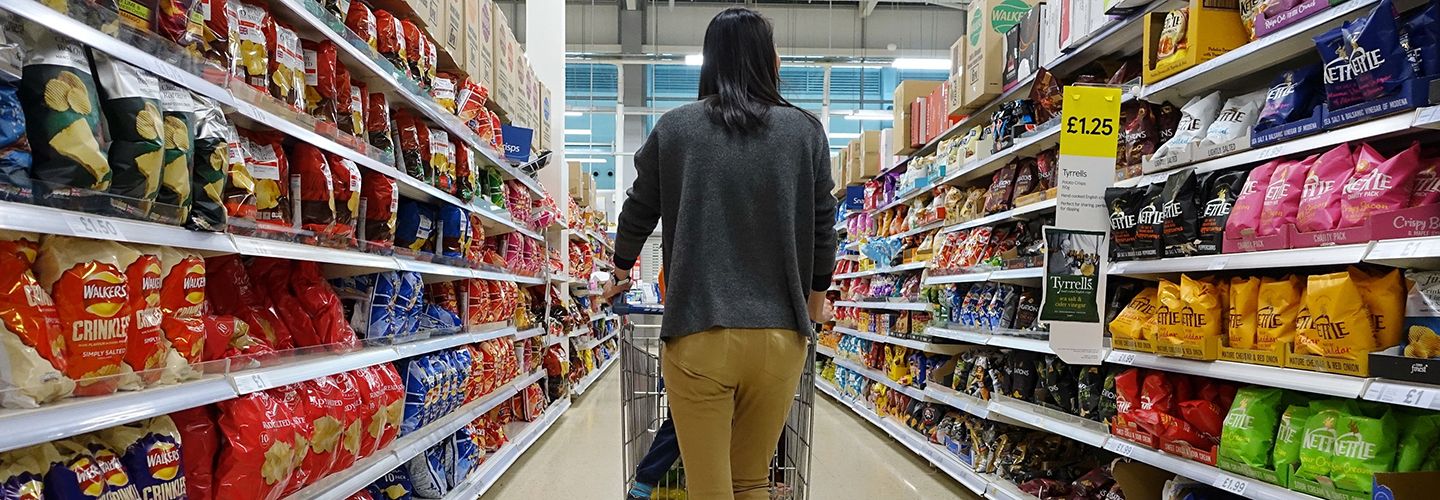New research by the NIHR funded Obesity Policy Research Unit shows the multiple ways ultra-processed snacks high in fat, sugar, and salt (HFSS) become normalised in children’s diets, and how low-income families in England lack the resources to mitigate this and foster healthier habits in children.
By Mr George Wigmore (Senior Communications Officer), Published
New research finds that healthy snacks – such as fruit – are out of reach for many parents on low incomes, with it making more sense to spend limited resources on ultra-processed (UP) snacks such as chocolate and crisps which have long shelf lives and are likely to be enjoyed by children, rather than on more expensive fresh produce which may go off quickly and risks being rejected. Furthermore, multi-buy deals and promotions on UP snacks makes them appear better value for money.
In contrast, the study, from City, University of London, found that families with higher incomes are positioned to continually stock their homes with children’s preferred fruits and offer these as alternatives to packaged snacks. They were also able to sidestep retail environments with unhealthy temptations, instead opting for options like vegetable boxes, organic shops or online deliveries, effectively safeguarding their children from detrimental dietary influences and fostering healthier snacking habits.
A recurring theme in the research was the role of UP snacks such as crisps and chocolates as rewards and treats for families across income brackets. This practice, beginning in early infancy to facilitate inclusion in existing family practices, accelerated as children became more engaged in social events such as at birthday parties, playdates and seasonal celebrations.
Branded snack products indicating health benefits or marketed for children were trusted by parents. Provision of these snacks began in infancy and over time extended to a whole range of snack products on the ‘infant aisle’ in shops. Claims such as ‘one of your five a day’ or ‘no nasties’ were understood by parents as beneficial for health, creating what’s known as a ‘health halo’ effect even though these products may still be very high in sugar.
Implementation of recommendations outlined in the government’s 2020 National Food Strategy would help reduce the appeal and ubiquity of ultra-processed snacks. These include expanding access to Healthy Start Vouchers, guaranteeing a living wage that covers the cost of a healthy diet, sensory fruit and vegetable education in schools and greater regulation of misleading front-of-pack health claims. Introduction of schemes which promote enjoyment and accessibility of fruit and vegetables as a healthy snack will ultimately make it easier for parents to introduce these items as snacks in the home environment.
These findings are drawn from two investigations of food practices amongst parents across the income spectrum in England, conducted by the Centre for Food Policy at City, University of London between 2020 and 2022. Utilising a longitudinal approach, researchers conducted three rounds of in-depth interviews over one year, providing data on how snacking practices develop over time. The first study involved 60 parents interviewed when their infants reached 6-, 12-, and 18-months, while the second study engaged 62 parents with children aged 2 to 18 years. The 122 interview transcripts were analysed by researchers to understand snacking patterns across age groups and income levels.
First author of the study, Charlotte Gallagher Squires, Research Assistant at the Centre for Food Policy at City, University of London said:
Dr Paul Coleman, Honorary Senior Research Fellow at the Centre for Food Policy, City, University of London, and Senior Public Health Registrar at Leeds Teaching Hospital NHS Trust said:
The article has been published in the journal Proceedings of Nutrition Society.



